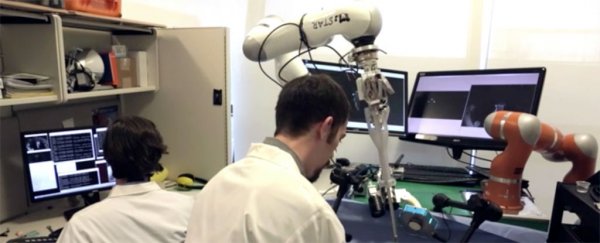There's been a lot of headlines in recent times about how machines will one day replace humans in a multitude of jobs, from automated transport to even automated journalism (gulp). While some of us have more to worry about than others, it seems reasonable to assume that exceedingly specialised work – such as medical care, for instance – might be a bit more sheltered from the coming robo-revolution.
But perhaps not. Scientists in the US have developed an autonomous surgical robot designed specifically to suture – or stitch up – soft tissue. And in testing, this surgical machine – which, it should be emphasised, operates entirely independently of human control – outperformed experienced human surgeons when operating on pig specimens.
"Our results demonstrate the potential for autonomous robots to improve the efficacy, consistency, functional outcome, and accessibility of surgical techniques," said associate surgeon-in-chief Peter C. Kim from the Children's National Health System in Washington. "The intent of this demonstration is not to replace surgeons, but to expand human capacity and capability through enhanced vision, dexterity and complementary machine intelligence for improved surgical outcomes."
While robot-assisted surgery is something that's existed for years, it's never been capable of handling the challenges of soft tissue, which shifts around as it's touched and operated on. But the new system, called Smart Tissue Autonomous Robot (STAR), is smart enough to factor this complexity into its own movement calculations.
"Until now, autonomous robot surgery has been limited to applications with rigid anatomy, such as bone cutting, because they are more predictable," said one of the team, Axel Krieger. "By using novel tissue tracking and applied force measurement, coupled with suture automation software, our robotic system can detect arbitrary tissue motions in real time and automatically adjust."
 Carla Schaffer/AAAS
Carla Schaffer/AAAS
The STAR's tracking system uses near-infrared fluorescent (NIRF) markers to give it a sense of its patient in three dimensions, while an algorithm that guides the robot detects changes in force and makes adjustments in real time as tissue moves.
In testing, the researchers compared STAR's handiwork to that of an experienced surgeon operating on both inanimate pig tissue, and live, anaesthetised pig specimens. The procedure, called anastomosis, involves stitching up two tubular structures, such as blood vessels.
"We chose the complex task of anastomosis as proof of concept because this soft tissue surgery is performed over 1 million times in the US annually," said Kim.
The results, reported in Science Translational Medicine, compared things such as the quality of the suturing, along with the amount of time the surgery took, and the number of mistakes made.
When it came to the quality of suturing, the robot beat the human surgeon, with more consistent stitching and less mistakes made. But in terms of the amount of time the surgery takes to perform, the machine came in second place. In the test involving live subjects, STAR took 35 minutes at its fastest, whereas the human surgeon only needed 8 minutes.
Still, given the precision of the robot skills, and the huge volume of soft tissue surgery people need – the researchers say almost 45 million operations take place in the US every year – it's an extremely promising start.
And the team also says the speed cited in the study wasn't STAR's record. "We can run the robot really, really fast," one of the researchers, Ryan Decker, told Melissa Healy at the Los Angeles Times. "But in this study, we really focused on… the outcomes, so we didn't run it as fast as we could."
The researchers are looking for a commercial partner to help them bring their technology into hospitals, and they say STAR could be stitching people up within two years if all goes well.
So then there's just the small matter of explaining to patients that the robot's entirely independent of the rest of the medical team… Considering how unsure people seem to be about the safety of driverless cars, the idea of a robot in the operating theatre might need some getting used to.
